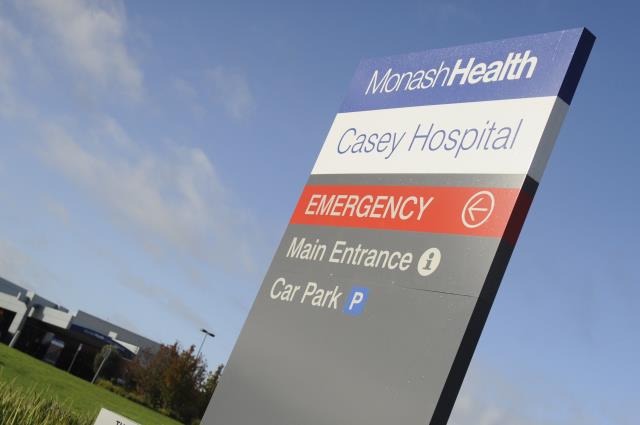Emergency waiting times have reduced at Casey Hospital but non-urgent planned surgery waits are on the rise, according to the latest official stats.
The latest Victorian Health Service Performance report shows the 90th percentile emergency department (ED) waiting times in the July-September quarter has dropped by 78 per cent to 34 minutes, compared to last year.
It was also considerably lower than the state average of 96 minutes.
The 90th percentile waiting time is the amount of time in which 90 per cent of all patients presented to an emergency department were seen by a nurse or doctor.
Over 80 per cent of patients in need of emergency care were treated within the recommended time across all triage categories, which met the statewide target for the second consecutive quarter.
While the percentage of patient transfers from ambulance to the ED within 40 minutes has slightly increased by 14 per cent since last year, it fell short of the statewide 90 per cent target.
However, the average overdue waiting time for non-urgent patients was almost 40 per cent longer than the statewide figure and 35 per cent more than last year.
Patients at Casey Hospital need to wait an average of 15 additional months for their non-urgent planned surgeries on top of the benchmark 12 months waiting period.
Dandenong Hospital has averaged similar overdue waiting times for non-urgent surgeries, with patients waiting for an overall 28 months.
About 2000 residents are on Casey Hospital’s waiting list across all planned surgery categories, with the waiting list steadily declining over the past year.
A Monash Health spokesperson said Victorian waiting lists for planned surgery, including at Casey Hospital, continued to be impacted from the effects of the Covid-19 pandemic and unprecedented demand from a growing and ageing population.
Since the pandemic, Monash Health commenced a surgical recovery program to reduce the long waitlist for planned surgeries.
The program includes expanding day surgery and upgrading surgery theatres to create greater access for the community.
It’s understood the initiatives have seen Monash Health reduce the long waitlist for planned surgeries by more than 30 per cent this year.
Victoria Healthcare Association (VHA) – the peak body for the state’s public health services – chief executive officer Leigh Clarke said the latest report showed good indicators that hospital performance was trending in the right direction but there was more work to be done to ease long-standing system-wide pressures.
“Our hospitals have been working extremely hard to speed up elective surgeries, cut emergency wait times and reduce the number of patients staying longer than they need to, all while working in an increasingly challenging operating environment,” she said.
Ms Clarke said that increasing demand for emergency services meant we could not afford to be complacent about the future effect of this trend on patient care.
“It is really pleasing to see government initiatives like the Covid Catch Up Plan and Planned Surgery Recovery and Reform program continuing to have an impact on waiting lists for planned surgeries,” she said.
“Investments like the Victorian Virtual Emergency Departments also appear to be helping to divert people with non-critical conditions away from busy emergency departments.
‘But we also know that many services are struggling in an increasingly complex operating environment with rising service delivery costs, ongoing workforce shortages and the need for investment in critical maintenance that meets community expectations.”
Ms Clarke added that the rising burden of chronic diseases, coupled with structural deficits in health budgets posed significant challenges that required sustained investment and collaborative efforts.
“Victorian hospital performance is on the path to recovery and there are positive signs some areas are returning to pre-pandemic levels, but we need to be mindful of where the pressure points are,” she said.
“The VHA wants to see targeted initiatives to ensure our health system continues to meet the standard of care that Victorians expect,” she said.
Meanwhile, urgent ambulance responses have improved in Casey but still well short of the benchmark, according to Ambulance Victoria’s latest statistics.
The body is required to respond to code-one emergencies within 15 minutes for 85 per cent of incidents statewide.
Casey had 64.7 per cent of responses up to the standard in the last quarter, marginally lower than the state average of 66 per cent.
This was a 6 per cent increase compared to the last quarter.
The average response time in Casey amounted to an average of 14.58 minutes – which was 14 seconds shorter than the state level.







